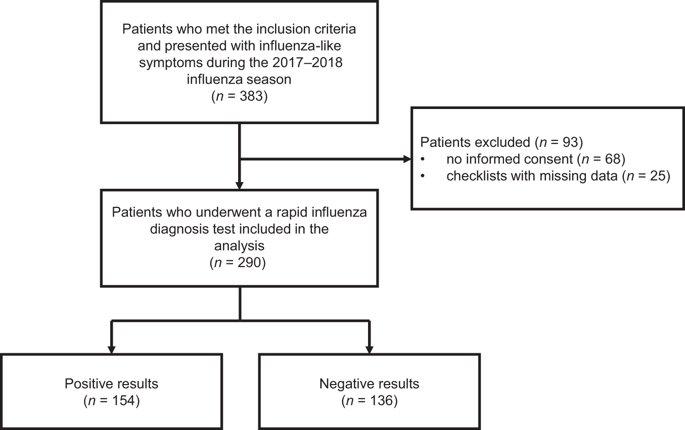当前位置:
X-MOL 学术
›
npj Prim. Care Respir. Med.
›
论文详情
Our official English website, www.x-mol.net, welcomes your
feedback! (Note: you will need to create a separate account there.)
Factors associated with seasonal influenza self-diagnosis: a prospective observational study in Japan.
npj Primary Care Respiratory Medicine ( IF 3.1 ) Pub Date : 2020-03-23 , DOI: 10.1038/s41533-020-0165-3 Hiroki Maita 1, 2 , Tadashi Kobayashi 3 , Takashi Akimoto 3 , Fumihiko Matsuoka 4 , Hiroshi Osawa 3 , Hiroyuki Kato 1, 2, 3
npj Primary Care Respiratory Medicine ( IF 3.1 ) Pub Date : 2020-03-23 , DOI: 10.1038/s41533-020-0165-3 Hiroki Maita 1, 2 , Tadashi Kobayashi 3 , Takashi Akimoto 3 , Fumihiko Matsuoka 4 , Hiroshi Osawa 3 , Hiroyuki Kato 1, 2, 3
Affiliation

|
This prospective observational study, conducted at a community clinic in Japan during the influenza season, from December 2017 to April 2018 aimed to investigate the accuracy of factors used for influenza self-diagnosis. Data were collected from pre-examination checklists issued to patients with suspected influenza and electronic medical records. Receiver operating characteristic (ROC) curve analysis was performed using a rapid influenza diagnostic test as the reference standard, and 2 × 2 contingency tables were analysed at each cut-off point. We analysed data from 290 patients (72.8% males, median age: 38 years, interquartile range: 26-50 years). The area under the ROC curve (AUC) for patients who were aware of other patients presumed to have influenza within close proximity was 0.74 (95% confidence interval (CI): 0.66-0.82). The AUCs for patients with a history of influenza, unvaccinated status, cough, or nasal discharge were 0.68 (95% CI: 0.60-0.75), 0.66 (95% CI: 0.59-0.73), 0.67 (95% CI: 0.59-0.75), and 0.70 (95% CI: 0.62-0.78), respectively. The sensitivity, specificity and positive likelihood ratio at a 90% cut-off point was 19.5% (95% CI: 13.5-26.6%), 94.1% (95% CI: 88.7-97.4%) and 3.31 (95% CI: 1.57-6.98). The sensitivity, specificity and negative likelihood ratio at a 10% cut-off point was 95.5% (95% CI: 90.9-98.2%), 9.6% (95% CI: 5.2-15.8%) and 0.48 (95% CI: 0.20-1.16). After multivariate logistic regression analysis, the AUC increased significantly from 0.77 (95% CI: 0.70-0.83) to 0.81 (95% CI: 0.76-0.86) when self-diagnosis-related information was added to basic clinical information. We identified factors that improve the accuracy and validity of influenza self-diagnosis. Appropriate self-diagnosis could contribute to the containment efforts during influenza epidemics and reduce its social and economic burden.
中文翻译:

与季节性流感自我诊断相关的因素:日本的一项前瞻性观察研究。
这项前瞻性观察研究于2017年12月至2018年4月在流感季节期间在日本的一家社区诊所进行,旨在调查用于流感自我诊断的因素的准确性。数据从发给疑似流感患者的检查前检查清单和电子病历中收集。使用快速流感诊断测试作为参考标准进行受试者工作特征(ROC)曲线分析,并在每个临界点分析2×2列联表。我们分析了290例患者的数据(男性为72.8%,中位年龄为38岁,四分位间距为26-50岁)。知道其他患者附近可能患有流感的患者,ROC曲线下面积(AUC)为0.74(95%置信区间(CI):0.66-0.82)。有流感史,未接种疫苗,咳嗽或流鼻涕的患者的AUC为0.68(95%CI:0.60-0.75),0.66(95%CI:0.59-0.73),0.67(95%CI:0.59-0.75) )和0.70(95%CI:0.62-0.78)。截止点为90%时的敏感性,特异性和阳性可能性比为19.5%(95%CI:13.5-26.6%),94.1%(95%CI:88.7-97.4%)和3.31(95%CI:1.57) -6.98)。截止点为10%时的敏感性,特异性和阴性可能性比为95.5%(95%CI:90.9-98.2%),9.6%(95%CI:5.2-15.8%)和0.48(95%CI:0.20) -1.16)。经过多因素logistic回归分析,将与自我诊断相关的信息添加到基本临床信息后,AUC从0.77(95%CI:0.70-0.83)显着增加到0.81(95%CI:0.76-0.86)。我们确定了可提高流感自我诊断的准确性和有效性的因素。适当的自我诊断可以在流感大流行期间为遏制工作做出贡献,并减轻其社会和经济负担。
更新日期:2020-03-23
中文翻译:

与季节性流感自我诊断相关的因素:日本的一项前瞻性观察研究。
这项前瞻性观察研究于2017年12月至2018年4月在流感季节期间在日本的一家社区诊所进行,旨在调查用于流感自我诊断的因素的准确性。数据从发给疑似流感患者的检查前检查清单和电子病历中收集。使用快速流感诊断测试作为参考标准进行受试者工作特征(ROC)曲线分析,并在每个临界点分析2×2列联表。我们分析了290例患者的数据(男性为72.8%,中位年龄为38岁,四分位间距为26-50岁)。知道其他患者附近可能患有流感的患者,ROC曲线下面积(AUC)为0.74(95%置信区间(CI):0.66-0.82)。有流感史,未接种疫苗,咳嗽或流鼻涕的患者的AUC为0.68(95%CI:0.60-0.75),0.66(95%CI:0.59-0.73),0.67(95%CI:0.59-0.75) )和0.70(95%CI:0.62-0.78)。截止点为90%时的敏感性,特异性和阳性可能性比为19.5%(95%CI:13.5-26.6%),94.1%(95%CI:88.7-97.4%)和3.31(95%CI:1.57) -6.98)。截止点为10%时的敏感性,特异性和阴性可能性比为95.5%(95%CI:90.9-98.2%),9.6%(95%CI:5.2-15.8%)和0.48(95%CI:0.20) -1.16)。经过多因素logistic回归分析,将与自我诊断相关的信息添加到基本临床信息后,AUC从0.77(95%CI:0.70-0.83)显着增加到0.81(95%CI:0.76-0.86)。我们确定了可提高流感自我诊断的准确性和有效性的因素。适当的自我诊断可以在流感大流行期间为遏制工作做出贡献,并减轻其社会和经济负担。









































 京公网安备 11010802027423号
京公网安备 11010802027423号